|
“Ruins of ‘lost city’ found under Cuban waters”
Granma, Cuba – December 12, 2001
“Using a robot submarine to explore Cuba’s seabed, researchers confirmed on Thursday the discovery of some stone structures which could have been constructed by an ancient and unknown civilization thousands of years ago.
Experts from a Canadian exploration company said that during the summer they filmed ruins of a possible “lost city” submerged off the coast of the Guanahacabibes Peninsula, on the western tip of the island.
‘It’s a marvelous structure which could possibly have been a great urban center,’ declared Paulina Zelitsky, Canadian oceanographer from the company Advanced Digital Communications (ADC)” –
[Full Story]
‘Lost city’ found beneath Cuban waters“
December 7 2001 That was headline at BBC News Online. It told of a sequence of symetrical structures discovered by marine explorers from a Canadian research company, Advanced Digital Communications, which has offices in Victoria, British Columbia, Canada, and Havana, Cuba. In a joint venture with the Cuban state partner, Geomar, the company has been working with the co-operation of the Cuban Academy of Sciences, whose Centre for Marine Archæology and Anthropology is currently studying footage of the structures taken by a video camera on board a Remotely Operated Vehicle (ROV).
The incredible discovery of megalithic structures some 2,200 feet underwater off the tip of the Guanahacabibes Peninsula, in western Cuba, was first announced by ADC President, Paulina Zelitsky, in May 2001, when sonar images bearing a remarkable resemblance to the pyramidal design of Mayan and Aztec temples in Mexico revealed the existence of numerous structures which appeared to be of cut granite.
|
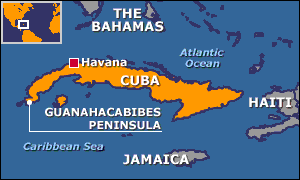
Copyright © 2001 BBC Online
|
|
In July 2001, the explorers from ADC returned to the site with the ROV which was capable of highly advanced underwater filming. BBC Online reported that Paulina Zelitsky had told the Reuters news agency:
“It’s a really wonderful structure which really looks like it could have been a large urban centre … However, it would be
totally irresponsible to say what it was before we have evidence”.
|
Linda Moulton Howe of Earthfiles.com reported the discovery on May 18 2001, quoting the full text of the Reuters story, and her follow-up interview with Barbara Moffet, Director of Plans and Programs, at the Communications Office of the National Geographic Society, in Washington, D.C. The Reuters story, which was filed by Andrew Cawthorne in Havana, Cuba, on May 15 2001, quoted Paulina Zelitsky as saying:
“We are the first people to see the bottom of Cuban waters over 50 meters. …It’s so exciting. We are discovering the influence of currents on global climate, volcanoes, the history of formation of Caribbean islands, numerous historic wrecks and even possibly a sunken city built in the pre-classic period and populated by an advanced civilization similar to the early Teotihuacan culture of Yucatan.”
Reuters reported that ADC was planning to use two submersibles to take people down to the depth of the large plateau where the 8 square miles of megalithic remains have been found, and that ADCs deep water equipment included a satellite-integrated ocean bottom positioning system, a high-precision side-scan double-frequency sonar, and remotely operated submarine robots.
In a comment that is highly reminiscent of the arguments of Masaaki Kimura, of the University of the Rykyus, Okinawa, Japan, about the ancient underwater structure off the coast of Yonaguni Jima, which is the southernmost of the Japanese islands, Paulina Zelitsky told Reuters:
“We don’t know what it is and we don’t have the videotaped evidence of this yet, but we do not believe that nature is capable of producing planned symmetrical architecture, unless it is a miracle, … It is stunning. What we see in our high-resolution sonar images are limitless, rolling, white sand plains and, in the middle of this beautiful white sand, there are clear manmade large-size architectural designs. It looks like when you fly over an urban development in a plane and you see highways, tunnels and buildings,”
Linda Moulton Howe followed up this story on November 19 2001 in a telephone interview with Paul Weinzweig, husband of Paulina Zelitsky, and co-owner with her of ADC. The story focussed on strange symbols and heiroglyphs
that can apparently be clearly seen in the video footage of the megalithic structure taken by their underwater robotic cameras. The Earthfiles article discussed the comparisons that Dr Weinzweig and Paulina Zelitsky had made with certain symbols that can also be found in a number of caves on Cuba, but Howe decided to do her own research on the symbols and heiroglyphs following recepit of photographs emailed to her by Zelitsky.
What she found was an interesting correlation with symbols originating in the ancient Minoan culture on the island of Crete, and Howe’s Earthfiles article included images of both. In the article Howe discussed the findings with Frank Joseph, Editor-in-Chief of the magazine, “Ancient American”, which specialises in research about the “Archaeology of the Americas before Columbus”. The discussion centred on the discovery on the underwater structures off Cuba of a symbol that Zelitsky had referred to as “The American Cross”, which is in fact two ‘crossed
ovals’.
They have been found in numerous caves in Cuba and on the island itself. Whilst discussing this symbol with Frank Joseph, Howe learned that it had also been used by early Etruscans. Howe helpfully reproduces some of these symbols in her article, which come from a page in a book she discovered whilst researching entitled “Language of the Sea Peoples”, by Fred Woudhuizen. Joseph told Howe:
“I haven’t seen what they found down there. It sounds like if it looks Greek, but isn’t Greek, that might be that it’s Etruscan. I’m not saying the site underwater is an Etruscan site. That’s probably unlikely. The Etruscans did not build things that look like Teotihuacan, that’s for sure! But the Etruscans, where did they get their written language? It’s possible that what we’re looking at in Etruscan is a variation of the Atlantean language. We don’t know what the Atlantean written language looks like. But it appears to be the precursor, not just of Greek, but other written languages in other parts of the world. So, it’s possible that if they look to Etruscan, they might be able to see some similarities. That’s not much help though. Even if they identify it as Etruscan, they won’t be able to read it because the Etruscan written language as not yet been deciphered.”
This is all good interesting stuff, but not everyone is convinced that there could be anything down that deep other than ‘natural structures’. The December 8 2001 edition of “The Independent” newspaper in the UK ran the headline: “Lost city found beneath Cuban waters may be a trick of nature”. It was written by its archæology correspondent, David Keys, whose book “Catastrophe” put forward a volcanic explanation for the cause of the European ‘Dark Age’, as opposed to the ‘cometary bombardment’ theory currently favoured by many researchers. Keys, sceptical of the claims of an ‘underwater city’, wrote that:
“Archæologists, however, believe that it is more likely that the explorers have found a relatively common phenomenon”.
In the usual argument we have seen over the past 5 years or more about the Yonaguni structures found underwater off the coast of that Japanese island, Keys interviewed Martin Dean, director of one of the world’s leading marine archæological institutions, the University of St Andrews’ Archæological Diving Unit, who told him:
“The world’s seas and oceans are full of underwater limestone, basalt and other natural geological formations, some of them covering many square miles, which are mistakenly interpreted as sunken cities with monotonous regularity.”
And, just for good measure, Keys put in his own two-penneth:
“Over recent years there have been a number of ‘sunken city’ claims and they have all turned out to be submerged limestone or other geological formations. Cracking in limestone often creates natural ‘pavements’ and other formations that can look very similar to structures made by humans. The site is also too deep for any human-made structures.”
He then interviews another sceptic, Dr Alistair Crame, head of the Geological Sciences Division of the British Antarctic Survey in Cambridge, who told him:
“It’s very unlikely that the seabed would drop 650m in 6,000 years. Normally geologists would expect such subsidence to occur over millions of years; 650 metres is also 550 metres below the lowest global sea levels experienced over the past million years.”
“Caribbean yields up sunken ‘lost city'”
IOL/The Star, South Africa – December 6, 2001
“Explorers using a miniature submarine off the coast of Cuba said on Thursday they had confirmed the discovery of stone structures deep below the surface that may have been built by an unknown civilisation thousands of years ago.
Researchers with a Canadian exploration company said they filmed ruins of a possible submerged “lost city” off the Guanahacabibes Peninsula on the Caribbean island’s western tip. They cautioned that they did not fully understand the nature of their find, and planned to return in January for further analysis.
The explorers said they believed the mysterious structures, discovered at the astounding depth of about 650m and laid out like an urban area, could have been built at least 6 000 years ago.” –
[Full Story]
“Five Ancient Shipwrecks Found in South China Sea”
People’s Daily, China – December 3, 2001
“A 12-member archaeological team with the state research center of underwater archaeology recently discovered five ancient shipwrecks in the sea close to Dongshan county of southeast China’s Fujian province.
One of the five shipwrecks has been determined as an international trade vessel navigating during the Qing Dynasty (1644-1911).
Zhang Wei, director of the state research center of underwater archaeology, said that the team located the five wrecks’ positions by means of high-tech sonar sensing devices. The success of this operation means more such explorations can be carried out in the future, he said.” –
[Full Story]
“Alexandria’s submerged antiquities for tourist diving”
Arabic News, Egypt – November 17, 2001
“The European Institution for Maritime Antiquities, working in cooperation with the Egyptian Department of Submerged Antiquities, has finished its annual mission at underwater sites near Alexandria.
Authority head Ibrahim Darwish said that the mission succeeded in cleaning up and preparing for tourist divers the location of Mark Antony’s palace, the Timonium.
It also cleaned up the wreckage of an ancient 35-metre wooden ship that lies on the bottom of Alexandria’s harbour.” –
[Full Story]
“Underwater Mounds Suggest Deap-Sea Gas Pockets”
ABC News, USA – October 31, 2001
“When Edward A. Keller got his first look at some recent high resolution images of the ocean floor off Santa Barbara, Calif., he saw things that were surprising, exciting, and a little unsettling. For openers, he saw what he believes to have been an ancient island, buried under the sea for thousands of years.
And he saw huge craters, one measuring at least 1,500 feet across, scattered along an earthquake fault zone like a series of open pits left behind by some aquatic miners.
He also saw mysterious mounds pushing up from the ocean floor, one more than 600 feet in diameter, and at first he didn’t have a clue as to what they were. After many months of pondering the evidence, the UC Santa Barbara geologist is fairly convinced now that the mounds conceal pockets of gas that could rupture through the ocean floor with possibly disastrous consequences for anyone unfortunate enough to be directly over them.” –
[Full Story]
“Atlantis ‘obviously near Gibraltar’“
September 20 2001 That was headline on the BBC News Online website. It told that a French scientist has pinpointed a possible location for Atlantis between the ancient coastlines of Spain and Morocco. Based on a study of sea levels that prevailed as the last Ice Age was ending, Jacques Collina-Girard, from the University of the Mediterranean in Aix-en-Provence, France, has published details about his work in the prestigious French journal, Comptes Rendus de l’Academie des Sciences. BBC News Online reported that he told New Scientist magazine:
“Nobody seems to have to have thought of the clearest indication given by Plato – that of an island at the mouth of the Pillars of Hercules.”
|
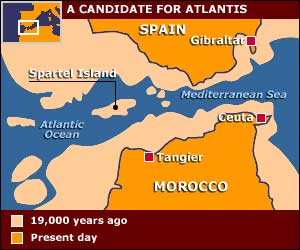
Copyright © 2001 BBC Online
|
|
Collina-Girard’s assessment of the coral reef data shows the coastline off the southernmost tip of Spain and around Gibraltar 19,000 years ago to have been around 130 metres (422 feet) below what it is today. This would have exposed an archipelago, with an island at the spot where Plato reported Atlantis to be in his work Timaeus.
At that time there had been an island in front of the ‘Pillars of Hercules’, in the area we now call the Strait of Gibraltar, though it was very much narrower then according to the BBC image that accompanied the story.
|
“Named Spartel, this island lay to the west of the Strait just as the Greek philosopher described. The Strait was longer and narrower than today, and enclosed a harbour-like inland sea.”
Over the years, explorers and even archæologists have looked in almost every nook and cranny all over the world for remains of the legendary ‘lost city of Atlantis’. These have ranged from the Celtic Shelf
to the Caribbean, the Azores, the Canaries, Iceland, Crete, Tunisia, Sweden, the coast of Western Africa and even the Sahara. More recently, over the past 5 years or so, there have been many discoveries of urban remains underwater off the coasts of Japan, India and Cuba, and modern technologies are producing a high number of anomalous data from sidescan sonar, and sub-bottom profiling of sea-beds, whilst being engaged in completely unrelated oceanographic research work.
These are indeed exciting times for those who appreciate that many millions of square miles of land were above sea-level before the series of abrupt glacial outpourings that marked the end of the last Ice Age. It is most likely that trade during the Ice Age was conducted by sea, as it was for hundreds of years during the current era, and so discovery of ‘port settlements’ should be expectedto be found at the ancient high tide areas that are now many hundreds of feet below current sea-levels. Collina-Girard says he made the Gibraltar discovery accidentally while investigating the possible migration patterns of Palaeolithic people:
“He says, however, that in a number of respects, Plato’s reporting simply does not square with the geological evidence. For example, Plato said Atlantis was larger than Libya and Asia combined, whereas Spartel was only 14 kilometers (8.75 miles) long by five km wide (3 miles) at the time.
It would be very strange indeed if the remains of ancient sea-shore settlements were not discovered in their hundreds on the coastal shelves of every continent in the next few years. And even stranger still if marine archæologists continue to bury their heads in the murky sands of treasure-hunting at the expense of the less lucrative business of exploring underwater remains.
“Bob Ballard at his second Black Sea mission”
Novinite, Bulgaria – August 11, 2001
“Doctor Robert Ballard, who discovered the exact location of the remains of the Titanic` and the `Bismarck`, will search for evidence that the Biblical deluge started in the Black Sea some 7,500 years ago.
Ballard has already gathered evidence that a great portion of the Black Sea coast was submerged by a catastrophic deluge some 7,500 years ago.
According the Biblical myth, the deluge started in the Middle East in 2,400 BC. The Bulgarian-American expedition will search for underwater remains from ancient settlements and ships. The Council of Ministers approved the August 15-31 implementation of the Bulgaria-US project ‘Black Sea 2001: Hydrolocator Research’.” –
[Full Story]
“Discovery of a lost world – submerged in the Arabian Sea”
Tribune India, India – July 8, 2001
“THE discovery of an ancient submerged in the Arabian Sea off the coast of Gujarat has raised a flutter among the historians and geologists in India. Many are disputing the existence of such a site in isolation, while others insist that this could lead to several other unknown settlements lying submerged under sea.
At the centre of this speculation are two government organisations — the National Institute of Ocean Technology (NIOT) and the Archaeological Survey of India (ASI). The latter claims to have been kept in the dark about the discovery, till it was announced in the papers.
The discovery, as is common with most archaeological finds, was accidental. Late last year, while on a reconnaissance mission in the Gulf of Cambay for an underwater gas pipeline project, a NIOT vessel took a series of high resolution photographs of the sea bed (actually, acoustic images) about nine kilometres west of Hazira in Gujarat.” –
[Full Story]
“SA expert hooks ancient fossil fish near N2”
IOL, South Africa – July 2, 2001
“A 360-million-year-old species of fish with elegant needle-like spines, previously unknown to science, has been discovered in a fossil-rich deposit on the outskirts of Grahamstown in the Eastern Cape.
The find was made by palaeontologist Robert Gess who has been working on the site, exposed by a 1985 cutting to re-route the N2 around the town for over ten years.
The deposit, a thick band of shale, marks the location of a brackish prehistoric estuarine lagoon, and has yielded a wealth of plant material, fish and fragments of a metre-long water scorpion.” –
[Full Story]
“Ancient fleet unearthed in Sardinia”
BBC News Online, UK – June 13, 2001
|
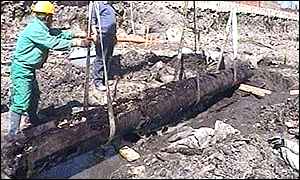
Copyright © June 13 2001
–
BBC News Online
–
|
|
“For half a millennium the port at the Bay of Olbia was the breadbasket of the Roman Empire, and some of its ancient ways can even be glimpsed today.
But Olbia is being updated, and workmen digging tunnels to end traffic jams have stumbled across the evidence of a naval disaster.
|
What they found was a full fleet of 12 cargo ships that used to ferry grain to Rome.
Over 1,600 years ago, the fleet was sunk in an act of war in what was then the Port of Olbia.”
[full story]
“Sunken city of Hercules uncovered”
The New Zealand Herald, New Zealand – June 12, 2001
“In the eighth century the ancient city of Herakleion vanished, overtaken by a mysterious natural disaster. Now divers are bringing its treasures to the surface, reports SUZANNE McFADDEN.
From the depths of a lost underwater world, a pharaoh and queen have emerged to the light of day for the first time in 1200 years.
Six kilometres off the Egyptian coast, divers have recovered colossal statues, bronze vessels, gold coins and jewellery lost when the legendary city of Herakleion sank into the Mediterranean Sea.” –
[Full Story]
“Spectacular finds of lost city revealed”
BBC News Online, UK – June 7, 2001
|
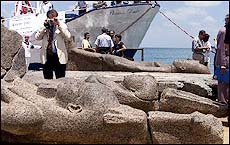
Copyright © June 7 2001
–
BBC News Online
–
|
|
“Treasures of the ancient sunken city of Herakleion off the coast of Egypt have been revealed to the public for the first time.
A joint Franco-Egyptian team of underwater archaeologists displayed some of their most spectacular finds at a press conference in Alexandria.
|
Herakleion was Egypt’s main port in the time of the pharaohs. Until its rediscovery last year, it was known only through Greek legends and a handful of ancient history books.
Researchers believe the city was sent to the bottom of the Mediterranean after an earthquake rocked the region more than 1,000 years ago.”
[full story]
“Indian seabed hides ancient remains”
BBC News Online, UK – May 22, 2001
|
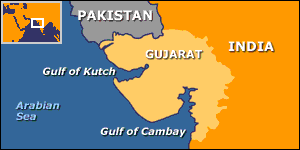
Copyright © May 22 2001
–
BBC News Online
–
|
|
“Marine experts have discovered a clump of archaeological structures deep beneath the sea off India’s western coast.
Although the discovery has not yet been accurately dated, the structures are said to resemble archeological sites belonging to the Harappan civilisation, dating back more than 4,000 years.
|
This is the first time man-made structures have been found in this part of the Arabian Sea which is known as the Gulf of Cambay.
The team leader, M Ravindran, told the BBC that they first noticed the huge structures while examining acoustic images collected from under the sea bed.”
[full story]
“Harappan-like ruins in Gulf of Cambay”
The Hindu, India – May 19, 2001
“In a major marine archaeological discovery, the Indian scientists have come up with excellent geometric objects below the sea-bed in the western coast, similar to the Harappan ruins.
‘This is the first time that such sites have been reported in the Gulf of Cambay,’ the Science and Technology Minister, Dr. Murli Manohar Joshi, told reporters today.
The discovery was made a few weeks ago when the multi- disciplinary underwater surveys, carried out by the National Institute of Ocean Technology (NIOT), picked up images of several ‘excellent geometrical objects’ which were normally man-made in the nine-kilometre-long stretch, west of Hazira in Gujarat.” –
[Full Story]
“Ancient sunken city giving up its treasures”
IOL/The Star, South Africa – April 10, 2001
“French underwater explorer Franck Goddio has unveiled his first complete underwater map of the sunken ancient city of Alexandria.
In 1996, Goddio discovered the fabled city quarters which had been lost for more than 1 000 years.
Since then, the underwater archaeologist has worked with a team of experts to map out the harbour with its fabulous palaces, temples and the famous royal island of Antirhodos.” –
[Full Story]
|
|
To understand why this News Page is sometimes late here is some information about Fibromyalgia
if you would like to support our marine archaeology research
The Morien Institute
Research Projects
please send us a book

from our Wish List
…
exclusive
…
October 2002
Morien Institute
illustrated interview with
Professor Masaaki Kimura
of the University of the Ruykyus,
Okinawa, Japan, regarding
the discovery of:
“Megalithic structures found underwater off the coast of
Yonaguni-jima, Japan”
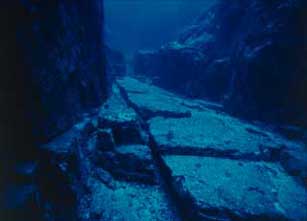
…
exclusive
…
June 2002
Morien Institute
illustrated interview with
Dr Paul Weinzweig
of Advanced Digital Communications,
Havana, Cuba, regarding
the discovery of:
“Megalithic urban ruins discovered off the coast of Cuba”
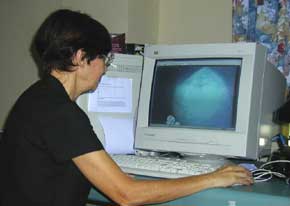
Books about
Underwater Discoveries

“Submerged Cultural Resource Management: Preserving and Interpreting Our Sunken
Maritime Heritage”
James D. Spirek (Editor),
Della A. Scott-Ireton (Editor)
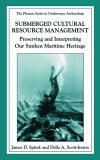
EU English Edition
“This vital book is a collection on the various ways archaeologists and resource managers have devised to make available and interpret submerged cultural resources for the public, such as underwater archaeological preserves, shipwreck trails, and land-based interpretive media and literature. The concept of preserves, parks, and trails has proven to be an effective and popular method of public education and heritage tourism with the end result being a greater public understanding of the value of preserving and protecting shipwrecks, and other submerged cultural resources, for the future.
Within each contribution, the authors focus on: legislation; economic benefits; interpretation methods; problems and successes; future directions regarding their preserve, park, or trail programs. Various approaches to the concept have been explored and this book is an effort to make available our experiences in the management of submerged cultural resources for the public. This volume is an invaluable resource to underwater archaeologists, cultural and heritage resource managers, museum and heritage educators and those studying these professions.”
“Atlantis and Earth’s
Shifting Crust”

VHS NTSC version
(USA and Canada)
“Eden in the East: The Drowned Continent of Southeast Asia”
Stephen Oppenheimer

EU English Edition
“A book that completetly changes the established and conventional view of prehistory by relocating the Lost Eden – the world’s 1st civilization – to SouthEast Asia. At the end of the Ice Age, SouthEast Asia formed a continent twice the size of India, which included Indochina, Malaysia, Indonesia and Borneo.
The South China Sea, the Gulf of Thailand and the Java sea, which were all dry, formed the connecting parts of the continent. Geologically, this half sunken continent is the Sunda shelf or Sundaland. He produces evidence from ethnography, archaeology, oceanography, from creation stories, myths and sagas and from linguistics and DNA analysis, to argue that this founder civilization was destroyed by a catastrophic flood, caused by a rapid rise in the sea level at the end of the last ice age.”
“Maritime Archaeology: A Technical Handbook”
Jeremy Green
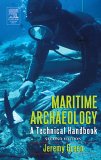
EU English Edition
“Jeremy Green’s systematic overview of maritime archaeology offers a step-by-step description of this fast-growing field. With new information about the use of computers and Global Positioning Systems, the second edition of this handbook shows how to extract as much information as possible from a site, how to record and document the data, and how to act ethically and responsibly wth the artifacts.
Treating underwater archaeology as a discipline, the book demonstrates how archaeologists, “looters,” academics, and governments interact and how the market for archaeological artifacts creates obstacles and opportunities for these groups. Well illustrated and comprehensive in its approach to the subject, this book provides an essential foundation for everybody interested in underwater environments, submerged land structures, and conditions created by sea level changes.
* Covers five broad areas: searching for sites, recording sites, excavation, management of collections, and study, research and publication.
* Describes a variety of techniques and procedures in considerable detail, accessible to both professional and amateur archaeologists.
* More than 250 photographs, charts, and diagrams explain everything from how to operate a sextant and a hand-held GPS to how a swim line should be laid out by the dive team before excavation begins.”
“Discovery of Atlantis:
Startling New Evidence and
the Case for Cyprus”
Robert Sarmast
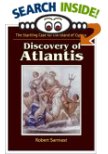
EU English Edition
“Plato provided 53 physical clues in his famous dialogue Critias–the original account of the story of Atlantis that is the sole basis of all Atlantis research. Discovery of Atlantis proves that the island of Cyprus and the underwater landscape just south of Cyprus is a perfect match with 51 of these clues. Exclusive 3D bathymetric maps based on new scientific data show for the first time a stretch of sunken land off of Cyprus.
The general layout of the landscape of Atlantis as described by Plato is easily discernible on this underwater landmass, as well as the precise location of its capital–Atlantis City. This robust empirical data is joined with other original findings based on mythological analysis and historical research, making the case for Cyprus increasingly obvious.”
“Man: 12, 000 Years Under the Sea, a Story of Underwater Archaeology”
Robert F. Burgess &
George F. Bass

EU English Edition
“Man: 12,000 Years Under the Sea is the dramatic story of underwater archaeology. The work looks back at Greek divers’ discovery of ancient statues in the sea, and covers the history of marine archaeology to the present, including the recovery of Ice Age Man’s 12,000-year-old remains from the bottom of Florida springs. Burgess writes from his experience for an assured exciting read.
|














